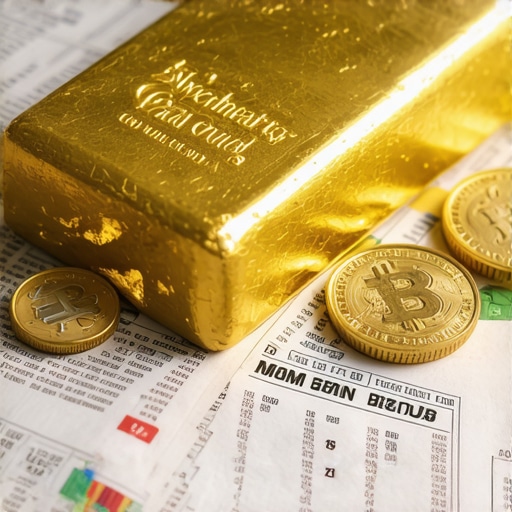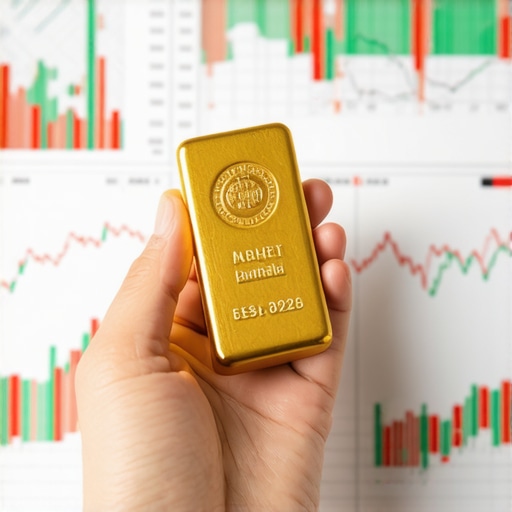What is a Gold IRA Account?
A Gold IRA (Individual Retirement Account) is a type of retirement account that allows you to invest in physical gold and other precious metals. Unlike traditional IRAs that typically hold paper assets like stocks and bonds, a Gold IRA provides a way to diversify your portfolio by including tangible assets. This can be particularly appealing to investors looking to hedge against inflation and economic uncertainty.
Why Should You Consider a Gold IRA?
Investing in a Gold IRA can offer several benefits. First, gold has historically been a safe-haven asset, maintaining its value even during market downturns. Furthermore, a Gold IRA is a tax-advantaged account, meaning you can defer taxes on gains until you withdraw funds in retirement. Many investors see this as a strategic move to enhance their retirement savings.
How Does a Gold IRA Work?
A Gold IRA functions similarly to a traditional IRA. You can contribute funds to your account, which can then be used to purchase eligible gold and other precious metals. It’s important to note that not all gold is eligible; the IRS has specific purity and quality standards for metals held in a Gold IRA. For example, only gold bullion that is 99.5% pure or higher can be held in an IRA.
Once you’ve selected your gold, a custodian will manage the account and ensure that the gold is stored in an approved facility. This adds a layer of security, as your investments are not only protected but also compliant with IRS regulations.
What to Look for When Choosing a Gold IRA?
When selecting a Gold IRA provider, consider factors such as fees, storage options, and customer service. Look for a company with a solid reputation and positive reviews from other investors. It’s also wise to evaluate their educational resources and whether they provide guidance on investment strategies.
For example, Investopedia provides a thorough overview of the rules and regulations surrounding Gold IRAs, which can help inform your decision. Additionally, understanding your own financial goals will help you determine how much to invest in gold compared to other assets.
Conclusion: Is a Gold IRA Right for You?
A Gold IRA can be a valuable addition to your retirement strategy, especially if you are concerned about the volatility of traditional markets. By investing in physical gold, you may find peace of mind knowing your assets are secured against economic turbulence. As you explore your options, consider consulting with a financial advisor who specializes in precious metals to ensure it aligns with your overall investment strategy.
Are you thinking about starting a Gold IRA? Share your questions or experiences in the comments below!
Understanding the Costs of a Gold IRA
When exploring a Gold IRA, it’s crucial to understand the associated costs. These can include setup fees, annual maintenance fees, and storage fees for the physical gold. Each provider has a different fee structure, so be sure to compare them. According to Wikipedia, transparency in fees is essential for informed decision-making, so always ask potential custodians for a complete breakdown of their charges.
What Types of Gold Can You Include in a Gold IRA?
Investors often wonder about the types of gold eligible for a Gold IRA. The IRS permits specific forms of gold, including bullion coins, bars, and certain collectibles. Popular choices include American Gold Eagles, Canadian Gold Maple Leafs, and gold bars produced by accredited refiners. It’s vital to ensure that any gold you wish to invest in meets the IRS’s purity standards of 99.5% or higher for it to qualify for your account.
Can You Transfer Existing Retirement Accounts to a Gold IRA?
Many individuals consider transferring their existing retirement accounts into a Gold IRA. This process, known as a rollover, allows you to move funds from a traditional IRA or 401(k) without incurring early withdrawal penalties. However, it’s essential to follow the IRS guidelines to avoid tax consequences. Consult with your financial advisor to understand the nuances of this process and how it can benefit your retirement strategy.
Benefits of Diversifying with a Gold IRA
Diversification is a critical principle in investing, and a Gold IRA can play a vital role in that strategy. By including physical gold in your retirement portfolio, you can reduce volatility and hedge against inflation. As mentioned in articles from Investopedia, gold has historically acted as a safe-haven asset, especially during economic downturns. This characteristic can help stabilize your overall investment performance.
Additionally, as the global demand for gold continues to rise, its value may appreciate over time, further enhancing your investment’s potential for growth. Whether you’re a novice investor or looking to refine your current strategy, understanding the long-term benefits of a Gold IRA can be invaluable.
Are you ready to explore more about investing in a Gold IRA? Share your thoughts or ask questions in the comments below, and check out our related article on what to look for when buying physical gold investments for additional insights!
Evaluating Gold Demand Trends: Impacts on Your Investments
Understanding gold demand trends is essential for any investor looking to navigate the complexities of the gold market effectively. Various factors influence the demand for gold, including economic stability, geopolitical tensions, and shifts in consumer behavior. Keeping an eye on these trends can help you make informed decisions about your investments.
How Do Economic Factors Affect Gold Demand?
Economic factors play a pivotal role in determining the demand for gold. When economies experience uncertainty, such as recessions or political instability, investors typically flock to gold as a safe-haven asset. This increased demand often leads to higher gold prices, making it a strategic asset for those looking to protect their wealth. As noted by Investopedia, gold has historically performed well during periods of economic downturn, reinforcing its status as a reliable investment.
What Are the Key Indicators of Gold Demand Trends?
Several indicators can provide insights into gold demand trends. These include:
- Central Bank Purchases: Central banks around the world often buy gold to diversify their reserves. An increase in central bank purchases is typically a sign of rising demand.
- Jewelry Demand: Gold jewelry remains a significant driver of demand, especially in countries like India and China, where cultural factors promote gold as a symbol of wealth and status.
- Investment Demand: The popularity of gold ETFs and mutual funds has surged, reflecting a growing interest in gold as an investment vehicle.
Monitoring these indicators can help you anticipate market movements and adjust your investment strategy accordingly.
How to Align Your Investment Strategy with Gold Demand Trends
To maximize the potential of your investments, consider aligning your strategy with current gold demand trends. Here are some tips:
- Diversify Your Portfolio: Incorporate a mix of gold assets, including physical gold, ETFs, and mutual funds, to reduce risk and enhance potential returns.
- Stay Informed: Regularly read up on market analyses and expert opinions to stay ahead of trends. Resources like Bloomberg provide valuable insights into market dynamics.
- Consult Financial Experts: Engage with financial advisors who specialize in precious metals to tailor your investment strategy based on your individual goals and risk tolerance.
By staying proactive and informed, you can better position yourself to take advantage of market opportunities.
Conclusion: The Future of Gold Demand
The outlook for gold demand remains strong, driven by various economic and geopolitical factors. Understanding these dynamics can empower you as an investor. As you consider your investment strategy, remember to evaluate your options carefully and consult with experts to align with the evolving gold market.
Do you have thoughts on how gold demand trends might impact your investment decisions? Share your insights in the comments, and don’t forget to check out our related article on what to look for when buying physical gold investments for more tips!
Understanding Market Dynamics: Future of Gold Demand
The future of gold demand is closely tied to various market dynamics, including economic shifts, geopolitical tensions, and changing investor behavior. As global uncertainties persist, gold is expected to maintain its status as a safe-haven asset. Investors looking to secure their wealth often turn to gold during volatile times, reinforcing its value and demand. According to Bloomberg, increased central bank purchases and rising consumer interest in gold investments will likely drive demand in the foreseeable future.
What Factors Influence Gold Prices?
Several key factors influence gold prices, and understanding them can help you make informed investment decisions. These factors include:
- Inflation Rates: As inflation rises, the purchasing power of currency decreases, making gold an attractive hedge.
- Interest Rates: Lower interest rates tend to boost gold prices, as the opportunity cost of holding non-interest-bearing assets like gold diminishes.
- Geopolitical Tensions: Events such as wars, trade disputes, or political instability can lead to increased demand for gold.
By keeping an eye on these factors, you can strategically position your investments to capitalize on potential price movements.
How Can You Effectively Invest in Gold?
Investing in gold effectively requires a well-thought-out strategy. Here are some approaches to consider:
- Physical Gold: Investing in bullion, coins, or jewelry allows you to own tangible assets. Ensure that your purchases meet IRS standards if you plan to include them in a Gold IRA.
- Gold ETFs and Mutual Funds: These investment vehicles provide exposure to gold without the need to physically store it. They can be a convenient way to diversify your portfolio.
- Gold Mining Stocks: Investing in companies that mine gold can offer leveraged exposure to gold prices, potentially amplifying your returns.
Each of these options has its advantages and disadvantages, so consider your financial goals and risk tolerance when selecting your investment method.
Conclusion: Preparing for Your Gold Investment Journey
As you prepare to invest in gold, it’s essential to stay informed and adaptable to market changes. The evolving landscape of gold demand offers numerous opportunities for investors willing to navigate its complexities. Whether you choose to invest in physical gold, ETFs, or mining stocks, aligning your strategy with market trends will be crucial for maximizing your returns.
Are you ready to take the next step in your gold investment journey? Share your questions or experiences in the comments below, and explore our article on 10 reasons to invest in gold mutual funds in 2025 for more insights into diversifying your investment portfolio!
Frequently Asked Questions (FAQ)
1. What are the tax implications of a Gold IRA?
A Gold IRA allows you to defer taxes on gains until withdrawal, similar to a traditional IRA. However, distributions are taxed as ordinary income, so it’s essential to consult a tax advisor for personalized advice.
2. Can I invest in gold ETFs within a Gold IRA?
Yes, you can invest in gold ETFs as part of your Gold IRA. These funds provide exposure to gold without the need for physical storage, making them a popular choice among investors.
3. How do I choose the right custodian for my Gold IRA?
When selecting a custodian, consider their fees, reputation, customer service, and the educational resources they offer. Look for a company that specializes in precious metals and has positive reviews from other investors.
4. What types of gold can I include in my Gold IRA?
You can include gold bullion, coins, and certain collectibles that meet IRS purity standards of 99.5% or higher. Popular options include American Gold Eagles and Canadian Gold Maple Leafs.
5. Is it safe to invest in gold during market volatility?
Gold is often seen as a safe-haven asset during market volatility. Its value tends to remain stable or even increase when other investments decline, making it a strategic choice for risk-averse investors.
6. What fees should I expect with a Gold IRA?
Common fees associated with a Gold IRA include setup fees, annual maintenance fees, and storage fees for physical gold. Always ask potential custodians for a detailed breakdown of their fee structures.
7. How can I transfer funds from my existing retirement account to a Gold IRA?
You can transfer funds through a rollover process, which allows you to move money from a traditional IRA or 401(k) without penalties. Consult with a financial advisor to ensure compliance with IRS rules.
8. What is the minimum investment required for a Gold IRA?
The minimum investment for a Gold IRA varies by provider, but it typically ranges from $5,000 to $25,000. Check with your chosen custodian for specific requirements.
Authoritative Sources
1. Investopedia: A comprehensive source for financial education, providing insights into Gold IRAs and investment strategies.
2. Bloomberg: Offers up-to-date market analysis and trends affecting gold prices and demand.
3. IRS: The official source for information on retirement accounts, including rules and regulations pertaining to Gold IRAs.
Conclusion
Investing in a Gold IRA can be a strategic way to diversify your retirement portfolio and protect against economic uncertainty. By understanding the benefits, costs, and market dynamics discussed in this article, you can make informed decisions about your investments. Whether you choose to invest in physical gold or gold ETFs, aligning your strategy with current gold demand trends will be crucial for maximizing your returns. Are you ready to take the next step in your gold investment journey? Share your questions or experiences in the comments below, and explore our article on 10 reasons to invest in gold mutual funds in 2025 for more insights into diversifying your investment portfolio!










I’ve been considering a Gold IRA for some time now, especially with the ongoing economic shifts. It’s interesting to read how gold has remained a stable asset during downturns. I recently attended a financial planning seminar where they emphasized the importance of diversifying with alternative investments like gold. One thing that stood out to me is how the IRS has strict guidelines about the type of gold that can be included in these accounts. I wasn’t aware that only bullion with a purity of 99.5% or higher qualifies — that’s crucial information for anyone looking to invest.
Additionally, I think it’s worth noting that understanding the fee structures is vital, as you mentioned in the post. I plan to compare several custodians soon, but I’m still trying to wrap my head around the various fees involved. It’s great advice to seek a company with good educational resources; I feel that being informed can make a significant difference. Has anyone here had a good or bad experience with a particular Gold IRA provider? It could help narrow down the options. Overall, I appreciate the insights here!
Linda, your point about the IRS purity standards really hits the mark. The 99.5% threshold for gold eligibility in IRAs is something many investors overlook until they’re deep in the process. Regarding your question about fees and providers, from my experience, transparency in fee structures isn’t always consistent across custodians. Some providers bundle setup and storage fees in ways that aren’t immediately obvious, so it’s smart to request a detailed breakdown upfront. I found that providers who offered clear, easy-to-understand educational materials helped me make a more informed choice during the selection process.
It’s also worth considering the storage options carefully. While many custodians use secure depositories, the costs and accessibility can vary considerably. In my case, aligning the custodian’s storage and fee policies with my long-term investment strategy was crucial.
For those just diving into the world of Gold IRAs, how do you all weigh the trade-offs between lower fees and more comprehensive customer service? Has anyone negotiated fees directly with custodians or found unique strategies to manage the overall costs effectively? I’d love to hear others’ experiences on making these decisions.